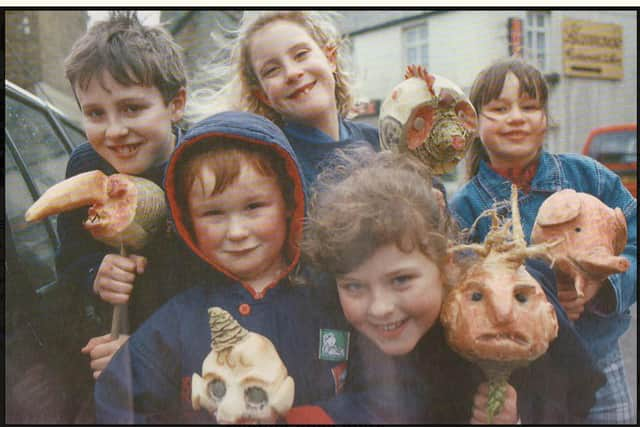The creepy 'Pop Day' neeps paraded on Bonfire Night in Orkney
In Stromness, competition was fierce to create the best and most gruesome ‘pop’ on November 5, with the neep heads paraded around the town ahead of the bonfire, with money collected by their young makers.
It is a tradition that lingers long in the town's memory and one that has enjoyed a little revival in recent years as parents hope to pass on the traditions which they once enjoyed.
Advertisement
Hide AdAdvertisement
Hide AdThe heads were carved into ghouls, aliens, animals or sometimes topical figures or celebrities, according to an article for Orkney Library and Archive.


Once money was gathered in, the neep heads were thrown onto the raging fire at the end of the night.
"The common cry is 'penny for me pop? – 'pop' being 'Pope'; a reminder of the days when effigies of the Pope were burned on a bonfire,” the article said.
Bryce Wilson, author and former curator of Stromness Museum, said it was unclear when Pop Day started, but the giving of money to pop carvers always made it a tempting enterprise for the young folk of the town.
Mr Wilson recalled a young George Mackay Brown knocking at the door of his parents’ house with his pop, probably around 1936 when Orkney’s finest poet was 15 or so.
The poet asked for a penny, but Mrs Wilson told him: "Georgie Broon, you are far too big to be going with your pop."
Mr Wilson said “great pride” was taken in the carving of a pop on what was a “great day” for the town.
He said: “Every household would amass pennies for the bairns that went for door to door. If it happened on a school day, then it commenced immediately after the school shut. On Saturday it would go on all day.
Advertisement
Hide AdAdvertisement
Hide Ad"Pop Day never happened on a Sunday, when it was postponed until the 6th November. The money was usually invested in fireworks, bangers and sparklers and sky rockets.”
Mr Bryce remembered bonfires in Stromness “at the north end and the sooth end and sometimes in between”, with the fire made chiefly of cardboard boxes donated by shopkeepers, who had stored them in sheds to keep dry.
He said: “It was indeed a great day. Nobody knew they were burning the Pope.
"It began to die out in recent decades when there were increasingly strangers living in the town. So about a decade ago the community council reinvented it as a competition to win prizes for the best pops, tossed then into a huge official bonfire with health and safety in mind.”
Then, parent Jacqueline Wilson recalled getting a few coppers when she went out with her pop as a child. In 2011, her son came home with £37.
She then said: “Of course we didn’t relate the pop to the Pope when we were youngsters.
"It wasn’t a religious thing, but it is one of our traditions and I feel passionately that it should be kept alive. Stromness is the only place where this is done and we are losing our identity in losing these things.”
Pop Day also took place in the village of Finstown, around seven miles east of Stromness, for a time.
A message from the Editor:Thank you for reading this article. We're more reliant on your support than ever as the shift in consumer habits brought about by Coronavirus impacts our advertisers.
If you haven't already, please consider supporting our trusted, fact-checked journalism by taking out a digital subscription.
Comments
Want to join the conversation? Please or to comment on this article.
